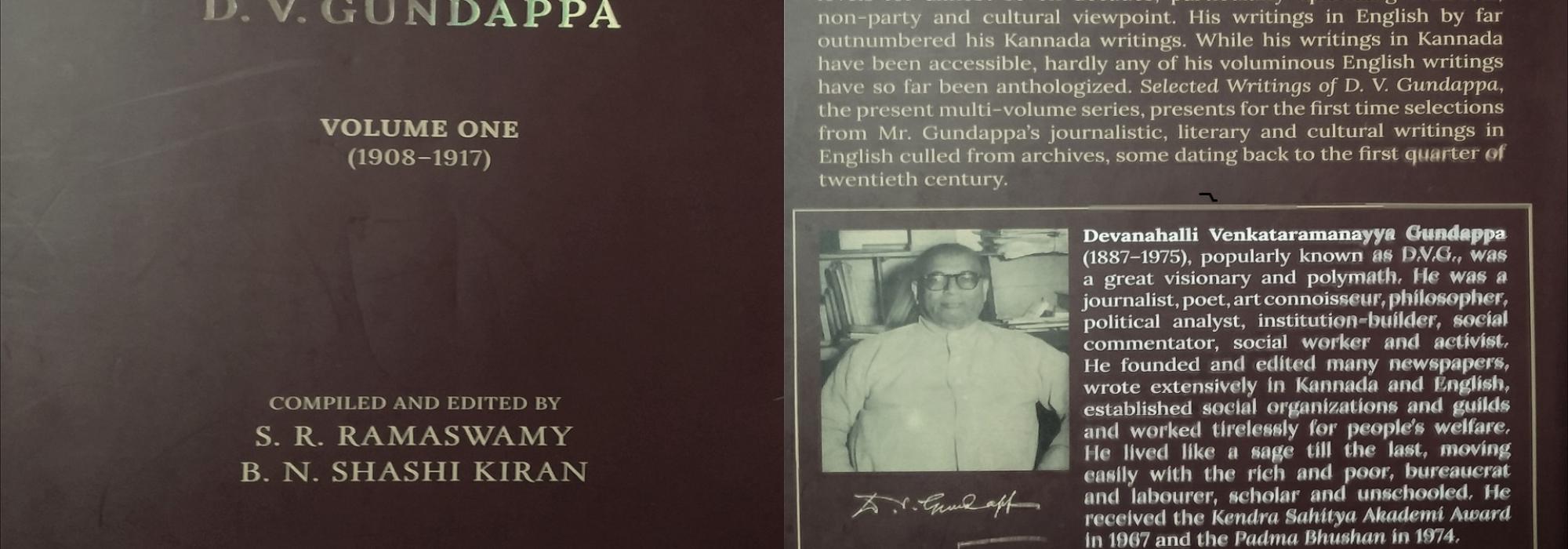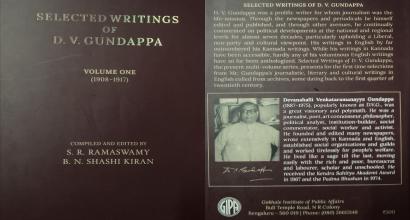Book reviews were a constant feature in all the journals DVG edited and published. He either reviewed himself or, if he happened to spot a well-written piece, he sought the permission of the author and published it. How to put a work in perspective and appraise its value within the packed confines of journalistic writing, and, more importantly, how to infuse literary charm into the prose? DVG answers these questions with his own reviews. Sample this pithy assessment of Planners’ Paradise, the fourth volume in the immensely illuminating Sotto Voce series by N Raghunathan:
Amid the soul-racking anxieties and fears of our day on the public scene and the near-anarchy even in private fields of life, he who would preserve his sanity and balance would turn the mind inwards and try to recover a steady view of things in their true bearings and find a scale of values to apply to them. Such a seeker of calm and clarity can find no better companion than ‘Vighnesvara’ to light up his path and take away the tedium of the search. The fourth volume of his Sotto Voce (Undertone Remarks) give us side-views of the Planners’ Paradise growing up around us in monumental shapes these two decades. The illustration on the cover is symbolic. It is row upon row of projection windows — long, long rows interrupted here and there by solid cubes of cement concrete, and still cars standing at the foot; — no sign of life inside or outside; no feet pattering; no shout or moan; no quiver of a leaf. An earthquake or a cyclone may bring down the brick-and-cement grandeur to the ground, to look more piteous than a thatched hut. Nay, it may even survive as built. Even so, a hut, housing life, would any day evoke more sympathy. Are the Plans connected with life as it is lived? What have the plans done for life and living? (p. 141)
DVG’s remarks on the then-ruling Tamil Nadu Government interfering with religion sound a warning bell for us today:
The plain fact is that men who are now running governments in India know nothing of religion and nothing of its mysteries and it is doubtful whether they know that they do not know. Religion is not physics or mechanics. It is beyond measurement and manipulation by man, and in all sobriety it is not necessary at all for the business of Government to meddle in this department of life … It will be enough if the Government will let them enjoy the freedom and rights which are guaranteed to ordinary citizens, namely, freedom from interference except where considerations of public health and public safety are involved. The Government of Tamil Nadu is showing dragon’s teeth by persisting in its resolve to meddle with old established institutions of religion and with the traditional religious divisions of the community. (pp. 168–69)
Long-standing knowledge of public affairs enabled DVG to clearly foresee how a political proposition would pan out. When Indira Gandhi’s Government decided to nationalize fourteen major private banks in 1969, DVG warned against it and outlined what would eventually ensue:
Nationalizing the banks will in effect be as follows:
- Concentrating economic power in the hands of Government and therefore in the hands of (a) the Ministers and (b) the political party in power at the time.
- The Ministers will be able to regulate the extension of credit facilities to banks’ customers.
- The large discretionary powers, which in the very nature of things should be vested in the bank’s manager or agent, would be virtually transferred to Ministers.
- The proprietors and directors of large industrial and commercial establishments will be thrown to the mercies of Ministers and their party men.
- The Ministers will have sway over officers and appointments in business houses.
- The Government will be able to commandeer all floating money in the banks to be spent on ideological objects.
Nationalization may thus come to mean de-nationalization routed through ministerialization in practice. (p. 222)
Commenting on the disintegration of Congress, DVG observed in a philosophical vein: “Burglars are united when acting, but divided when sharing the spoils. Ambition is natural, and everyone must get a chance. He fights for it, and become a hot-gospeller in the process. He is the sword that cuts.” (p. 229) Other things apart, he chided the Government for its refusal to inquire into the death of Lal Bahadur Sastri. He drew attention to Khrushchev’s reminiscences that record how prominent men unsuited to the Kremlin’s strategy were disposed of, and in that light insisted on a probe. (p. 343)
Today’s world is a victim of Wokeism, a vile movement spearheaded by the far-Left. Initially described as ‘a reference to awareness of racism and discrimination,’ it soon turned into a collective term that includes theories on race, gender and identity. In reality, it is a diabolical network of operations intending to topple all cultural structures and render a society rootless. It advocates an extreme type of individual liberty that erases all forms of group-identity. Evidently, this is twisted on multiple levels and deserves to be discarded for revolting against basic human nature. The precursors of Wokeism were ill-conceived attempts to achieve ‘universal brotherhood.’ DVG had the sagacity to look through the veneer of such grand-sounding, seemingly innocuous objectives:
There has come to be in our day a species of boneless and faceless philosophy of universal goodness bearing the adorable name of brotherhood. By softness of speech and smoothness of manner it hopes to overcome the hard rocks of psychology which rise as a wall between group and group and race and race. If we would work for world peace and human brotherhood, it is inevitable that we should recognize not only diversity of race and class but also the naturalness of prejudice incidental to such a diversity … To ask that you should transcend the effects of face and feature, and smell and sound is to ask you to become a transcendentalist — one superior to the influences of physical form and complexion … Until we can usher in such a world of perfected beings we have to put up with race and caste with all their potencies of prejudice and aversion, and the way of so living in this very imperfect world is to accustom ourselves to ways of tolerance and reconciliation. The way of peaceful co-existence is that each distinct element is assured of its safety, — non-meddling with another in fields where another is not wanted. This is the way also to inter-racial peace. In brief, it will be enough if races and castes assure one another of their right to exist, and exist purposefully. (pp. 379–80)
* * *
Volume Ten (1972–1973)
During the years 1972 and 1973 DVG was an octogenarian in failing health. Yet he continued to write in Public Affairs on cultural, literary and political topics.
DVG had founded several organizations—small and large, formal and informal—to serve the society in various ways. First-hand experience had taught him that the promoter of any social cause cannot be a loner; he has to seek support from philanthropists and people of influence. However, he should be wary about the people with whom he associates. DVG explains:
To a worker in civics or politics, alliance is indeed indispensable. But he must be careful about the company he chooses. If in his zeal for the cause he forgets the moral worth of the man whose help he seeks, the cause will stand to lose rather than gain. Where a man of principle and a man known to be of no principle join together in the service of any cause, it is the man of principle that will get worsted. The partner’s poses and tricks will be too much for the plain, straightforward man to cope up with. Avoid the false man, even when the compromise is itself a good one. Falsehood is always poison. Never flatter yourself that you are Lord Shiva, the poison digester. (p. 19)
In 1972 the Government issued guidelines on landholdings with limits varying from region to region, depending on the kind of land. These guidelines on ceilings eventually became an Act that redistributed land apart from prescribing limits for the size of landholdings. DVG used his knowledge of history and sound common sense to show how this idea is flawed:
All accumulation of property, whether land or cash, has been subject in our country to two delimiting factors. One is the death of the owner and the division of property that follows. The second is the tax-levying power of the State. These two factors have been recognized from time immemorial: “Chatvaro vitta-dayadyah dharma-agni-nrpa-taskarah.”
A propertied man has his sons, first of all, to inherit his property. If they are not given their due, then there are four cousins to raise their claims: (i) charity (ii) fire (iii) the State and (iv) thieves. This was the condition in ancient times. In any case, the tax-power of the State is a limitation on private property conceded on all sides. The question simply is whether it would be right to convert it into a power of deprivation of the subject. Just as the sovereign has rights, the subject has his own rights, and they indeed limit each other. The king owes protection as the subject owes loyalty … Permanency of tenure, it should be fundamentally noted, is a condition of well-doing and success in ownership. The ignoring, firstly of the natural working of laws of life and death, and secondly of the taxation powers of the State, is at the root of all the wild talk about restricting private property … Distribution of small bits of land among the needy is certainly not the way to reduce poverty. On the contrary, it is distinctly to increase inefficiency in agriculture and multiply the problems of poverty. Altogether the idea of curbing property is a mistaken one. (pp. 31–32)
DVG was associated with the University of Mysore in various capacities for long years. He was a member of its senate from 1927 to 1943 and a member of its executive council from 1933 to 1939. Close acquaintance with the workings of a prestigious University had helped him form well-reasoned thoughts on education. According to him, ‘research’ in our country has become a debased coin because of frequent abuse. He had called for the separation of research and teaching:
It would certainly make for clarity if the two cadres of ‘‘research’’ and ‘‘teaching’’ were kept distinct and separate in a college. Interchange may be permitted by the Vice–Chancellor on consideration of merit when a request comes up. Nor need there be any distinction in pay and conditions of service. A special allowance may be payable to the research-man so long as he is engaged in any approved scheme of research. The mixing up of the two lines of service has often led to jealousy and heartburn, affecting the mind and the temper of the class–teacher, the student being the sufferer. The spurious and the meretricious must be rigorously kept out and academic values upheld with every care. (p. 40)
Nadoja S R Ramaswamy introduced me to the nuances of editing and provided incredible insights into the personality and works of D V Gundappa. Shatavadhani R Ganesh breathes life into all my activities. Sandeep Balakrishna patiently polished my prose and offered valuable suggestions to shore up the observations in this essay. I owe an immense debt of gratitude to all of them.
To be continued.








































